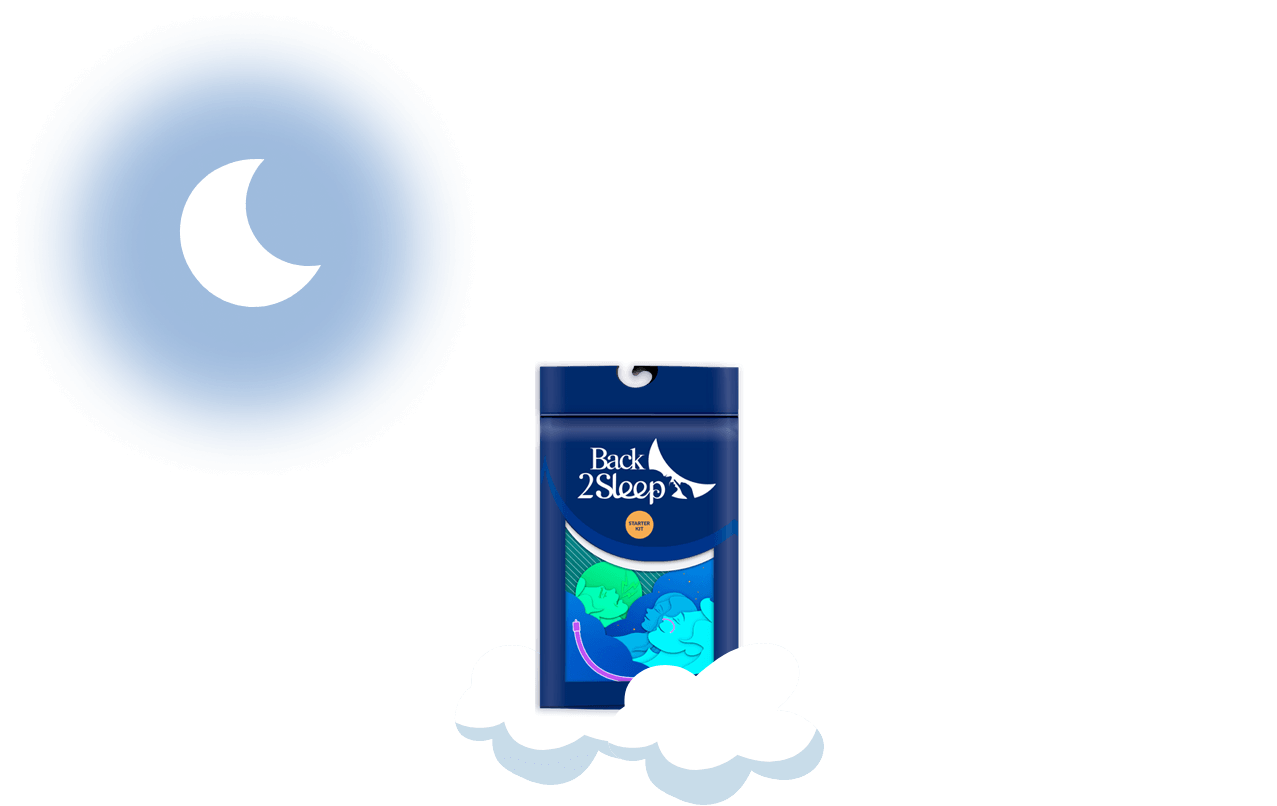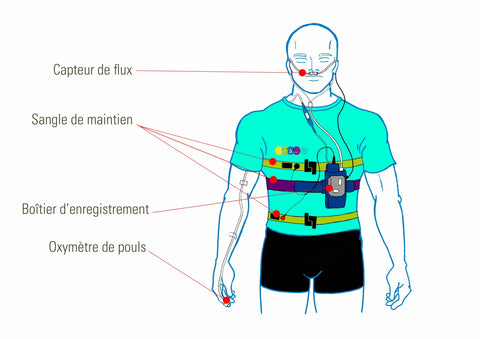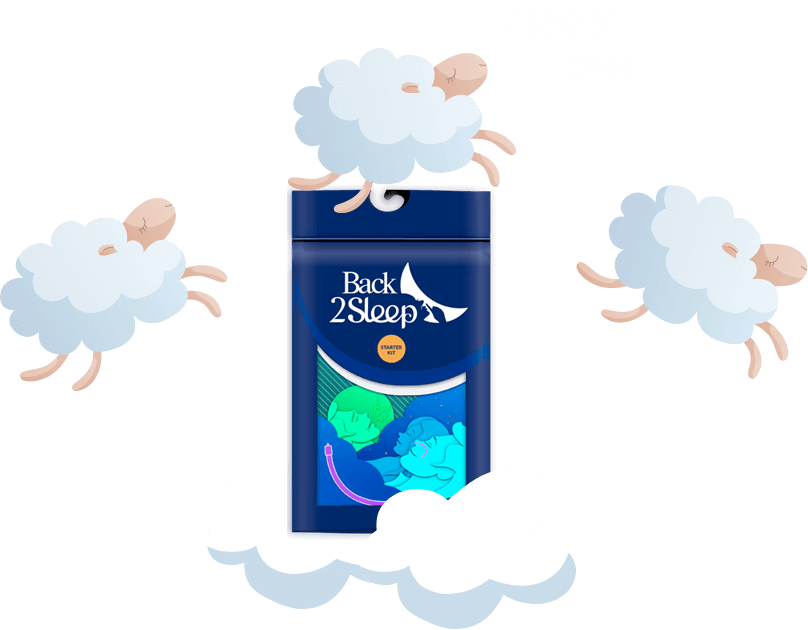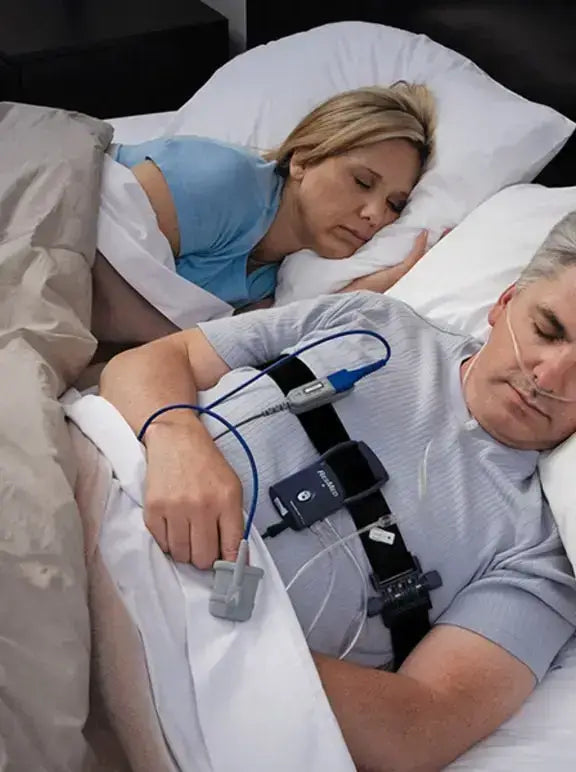Test per l'apnea notturna a casa: guida completa alla valutazione del sonno a domicilio
Ti chiedi se puoi valutare il tuo sonno a casa? Scopri come il test per l'apnea notturna a casa misura respirazione, frequenza cardiaca e ossigenazione tranquillamente nel tuo letto, oltre alla rivoluzionaria soluzione Back2Sleep per un sollievo immediato.
Ti chiedi se puoi valutare il tuo sonno a casa? Il test per l'apnea notturna a casa è la soluzione che ti permette di misurare respirazione, frequenza cardiaca e ossigenazione mentre dormi tranquillamente nel tuo letto - è un modo comodo e discreto per ottenere dati sul sonno senza le limitazioni del laboratorio, e se combinato con trattamenti innovativi come l'ortesi intranasale Back2Sleep, puoi ottenere miglioramenti immediati nella qualità del sonno.

Facile da usare, ti permette di misurare mentre dormi tranquillamente nel tuo letto:
- 💊 la tua respirazione
- 💊 frequenza cardiaca
- 💊 ossigenazione
È un modo comodo e discreto per ottenere dati sul sonno, senza le limitazioni di una notte in laboratorio.
Test del sonno a casa in cifre
Cos'è il Test dell'Apnea del Sonno a Casa?
Perché Scegliere un Test a Casa?
Scegliere un test a casa significa scegliere comfort e semplicità. Immagina: niente bisogno di dormire in un ambiente estraneo, circondato da macchinari intimidatori - stai tranquillo, molti pazienti lo fanno!
Esegui il test nel tuo letto, circondato dai tuoi punti di riferimento abituali. Inoltre, riduci l'ansia e spesso ottieni risultati più rappresentativi del tuo sonno naturale.
💡 Vantaggio Chiave: Il test a casa fornisce risultati più naturali poiché dormi nel tuo ambiente familiare, riducendo l'ansia da test e migliorando la precisione dei dati.
Dispositivi Utilizzati per il Test a Casa
I dispositivi per il test dell'apnea del sonno a casa sono progettati per essere sia precisi che non invasivi.
Generalmente consistono in:
- 💊 un sensore di flusso respiratorio
- 💊 una fascia toracica per misurare lo sforzo respiratorio
- 💊 un ossimetro da dito per monitorare la saturazione di ossigeno
È un intero laboratorio del sonno miniaturizzato, progettato per fornirti dati sulla tua salute senza disturbare il tuo riposo.
Scopri di più sull'apnea del sonnoComponenti Chiave del Test del Sonno a Casa
Monitoraggio Respiratorio
Misura i modelli di respirazione, rilevando pause e riduzioni del flusso d'aria durante la notte per identificare episodi di apnea.
Monitoraggio della Frequenza Cardiaca
Il monitoraggio continuo dell'attività cardiaca rivela lo stress sul sistema cardiovascolare durante le interruzioni della respirazione.
Saturazione di Ossigeno
La pulsossimetria monitora i livelli di ossigeno nel sangue, identificando cali pericolosi che si verificano durante gli episodi di apnea.
Rilevamento del Movimento
Registra i cambiamenti di posizione durante il sonno e i risvegli, fornendo informazioni sulla qualità e le interruzioni del sonno.

Come Ottenere il Dispositivo Poligrafo Ventilatorio?
Consultazione con un Professionista Sanitario
Il primo passo è consultare un medico, preferibilmente uno specialista del sonno. Dopo una valutazione iniziale dei tuoi sintomi e forse uno studio preliminare del sonno, il medico può prescrivere un poligrafo ventilatorio domiciliare. Questa prescrizione è importante per l'accesso al dispositivo.
Scelta di un Fornitore Approvato
Con la prescrizione in mano, il passo successivo è scegliere un fornitore approvato per ottenere il dispositivo. 💊 Ospedali, 💊 centri per il sonno, 💊 alcuni fornitori di servizi medici domiciliari offrono questi dispositivi. È importante selezionare un fornitore affidabile per garantire la qualità e l'affidabilità del dispositivo.
Formazione sull'Uso del Dispositivo
Una volta ottenuto il dispositivo, una formazione adeguata sul suo utilizzo è essenziale. I fornitori solitamente offrono una sessione introduttiva per familiarizzare con il dispositivo, mostrandoti come configurarlo e usarlo correttamente per garantire risultati affidabili.
Come Prepararsi per il Test Domiciliare dell'Apnea Notturna?
Installazione dell'Hardware
Installare l'apparecchiatura è un passaggio fondamentale per garantire l'affidabilità del tuo test domiciliare per l'apnea notturna. Ecco una guida passo passo per aiutarti:
Leggi il Manuale
Prima di tutto, prenditi il tempo di leggere le istruzioni fornite con il tuo kit. Ogni dispositivo può avere caratteristiche specifiche che è fondamentale comprendere.
Preparazione del Sensore
In generale, dovrai posizionare i sensori su: 💊 il torace, 💊 il dito, 💊 la testa. Assicurati che ogni sensore sia correttamente carico o dotato di batterie nuove.
Posizionamento dei Sensori
Sensore toracico: posizionalo intorno al torace. Ossimetro: fissalo comodamente al dito. Sensore del flusso nasale: posizionalo per captare la respirazione.
Controllo Funzionale
Accendi il dispositivo di registrazione. Controlla gli indicatori luminosi e sonori per assicurarti che tutto funzioni correttamente prima di dormire.

Quinto passo - posizionamento per il sonno: una volta che tutto è installato, sdraiati e prova a muoverti leggermente per assicurarti che nulla si sposti o si allenti. È importante che i sensori rimangano al loro posto per tutta la notte per ottenere dati affidabili.
Trova l'Attrezzatura Vicino a TeConsigli per una Notte di Test di Successo
Una notte di test di successo richiede una preparazione meticolosa per garantire risultati affidabili. Ecco alcuni consigli per ottimizzare la tua esperienza:
Mantieni la tua routine: dormi agli orari abituali affinché il test rifletta accuratamente il tuo ritmo naturale del sonno.
Crea un ambiente favorevole al sonno: assicurati che la tua camera sia buia, silenziosa e a una temperatura confortevole.
Evita stimolanti: limita il consumo di caffeina e alcol, specialmente nelle ore prima di dormire.
Fai attenzione ai farmaci: alcuni medicinali possono influenzare il sonno. Consulta il tuo medico per sapere se puoi evitarli o modificarne l'assunzione.
Rilassati prima di dormire: adotta una routine rilassante prima di andare a letto, come leggere un libro o fare un bagno caldo.
Gestisci l'ansia legata al test: pratica tecniche di rilassamento o meditazione per calmare la mente.
Interpretazione dei Risultati del Test Domiciliare per l'Apnea del Sonno

Comprendere gli Indicatori
Interpretare i risultati del test domiciliare per l'apnea del sonno richiede la comprensione di alcuni termini e indicatori chiave. Ecco una panoramica degli elementi principali che incontrerai:
| Indicatore | Descrizione | Intervallo Normale |
|---|---|---|
| Indice di Apnea-Ipopnea (AHI) | Numero medio di pause significative o riduzioni della respirazione per ora di sonno | <5 normale | 5-15 lieve | 15-30 moderato | >30 grave |
| Saturazione di Ossigeno | Percentuale di ossigeno nel sangue durante il sonno | Sopra il 95% normale | Valori più bassi indicano privazione di ossigeno |
| Eventi Respiratori | Apnee (cessazione completa) e ipopnee (riduzione della respirazione) | Frequenza e durata determinano la gravità |
| Movimenti e Risvegli | Interruzioni del sonno e cambiamenti di posizione | Indica la qualità del sonno e l'impatto respiratorio |
Quando Consultare uno Specialista?
Se i tuoi risultati rivelano anomalie, o se il tuo AHI supera la norma, è il momento di consultare uno specialista del sonno. Questo professionista sarà in grado di interpretare i tuoi dati nel contesto più ampio della tua salute e dei sintomi e sviluppare un piano di trattamento appropriato.
⚠️ Non sottovalutare i risultati: sono una finestra sulla tua salute notturna e agire su di essi può migliorare drasticamente la tua qualità di vita.
La Soluzione Back2Sleep: Ortesi Intranasale
L'ortesi intranasale di Back2Sleep è facile da usare e offre un comfort ottimale. Mira a mantenere le vie aeree aperte durante il sonno, riducendo il rischio di apnea e disturbi notturni.
Questo dispositivo può essere particolarmente utile per chi trova CPAP (Continuous Positive Airway Pressure) scomodo o invasivo.

Risultati immediati - Funziona dalla prima notte senza periodo di adattamento
Non invasivo - Più confortevole delle maschere CPAP o degli interventi chirurgici
Adatto ai viaggi - Soluzione portatile che funziona ovunque senza elettricità
Domande frequenti sul test per apnea notturna a casa
Esistono diversi tipi di apnea notturna, principalmente: 💊 apnea ostruttiva del sonno (OSA), 💊 apnea centrale del sonno, 💊 apnea mista. Il test a casa è generalmente progettato per l'OSA, che è il tipo più comune. Misura le interruzioni della respirazione dovute a ostruzione fisica delle vie aeree. Per altri tipi, in particolare l'apnea centrale, dove il cervello non invia i segnali giusti per respirare, potrebbe essere necessario un test di laboratorio più approfondito per una diagnosi precisa.
Sebbene pratici, i test a casa hanno i loro limiti. Non catturano l'intero spettro di dati che si potrebbero ottenere in un laboratorio del sonno, come: 💊 certi aspetti del movimento, 💊 posizioni durante il sonno, 💊 misurazioni neurologiche. Inoltre, se il test non è configurato correttamente, potrebbero esserci errori nei dati raccolti. Per i casi di apnea notturna grave, o per pazienti con altri disturbi del sonno, un test di laboratorio può fornire informazioni più complete e accurate.
Per massimizzare l'accuratezza dei tuoi risultati, segui attentamente le istruzioni di installazione. Assicurati che i sensori siano posizionati correttamente e che il dispositivo sia attivato. Mantieni il sonno il più naturale possibile durante il test. Dopo il test, la consultazione con uno specialista del sonno è essenziale per interpretare correttamente i risultati. Un professionista può non solo analizzare i dati, ma anche contestualizzarli con la tua storia medica e i sintomi.
Back2Sleep offre una soluzione immediata e non invasiva particolarmente efficace per chi è stato diagnosticato con apnea notturna da lieve a moderata tramite test a casa. A differenza delle macchine CPAP, è comodo, discreto e non richiede elettricità, rendendolo ideale per un uso costante.
Prendi il controllo della tua salute del sonno oggi
Che tu ti stia preparando per un test a casa o abbia già i risultati, Back2Sleep offre un sollievo immediato
Ordina il tuo kit Back2SleepPer saperne di più: Informazioni sul nostro dispositivo | Ultime ricerche | Contatta il supporto | Informazioni su Back2Sleep








